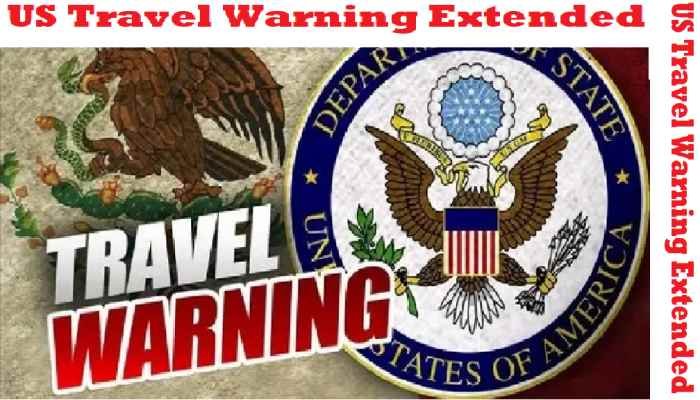
US Travel Warning Extended: What It Means for Travelers 2025
Updated on July 15, 2025 — On this day, the U.S. government officially announced the US Travel Warning Extended to several countries. These warnings are based on safety concerns, such as political unrest, terrorism, health risks, and natural disasters. If you are planning international travel, this is an important update to consider before booking flights or hotels.
In this blog, we will explain in detail:
-
What is US Travel Warning Extended?
-
Why was the US Travel Warning Extended?
-
Which countries are on the list?
-
What does this mean for U.S. citizens?
-
Travel safety tips for 2025
-
And more.
What is US Travel Warning Extended?
A travel warning is an official notice given by the U.S. Department of State. It tells U.S. citizens that certain countries or regions are dangerous to visit at the moment.
These warnings are not suggestions. They are serious alerts based on real risks. The government collects data from embassies, consulates, and intelligence sources. They then use this data to help protect travelers from harm.
Different Levels of Travel Warnings
There are four levels of US Travel Warning Extended used by the U.S. government:
-
Level 1: Exercise Normal Precautions
These places are mostly safe. Just be alert like you would at home. -
Level 2: Exercise Increased Caution
Some risks exist. Stay cautious and be aware of your surroundings. -
Level 3: Reconsider Travel
Serious risks exist. You should avoid travel unless necessary. -
Level 4: Do Not Travel
These are the highest risk zones. Avoid travel under any condition.
When a warning is extended, it usually means the situation in that country has not improved.
Also Read: Barcelona Tourism Protesters: Angry Over tourism in 2025
Why Was the US Travel Warning Extended?
There are many reasons why the US travel warning was extended in July 2025. Let’s take a closer look at the most important ones:
1. Ongoing Political Instability
Some countries are facing violent protests, civil wars, or government breakdowns. These issues create dangerous environments for both locals and tourists.
2. Increased Terrorism Threats
Terrorism remains a global threat in 2025. The U.S. government has reported increased risks of attacks on foreign visitors in some areas.
3. Public Health Issues
There are still concerns about infectious diseases, such as new virus variants or outbreaks of diseases like dengue, malaria, and bird flu. Some countries have weak healthcare systems, which makes it risky to fall sick while visiting.
4. Natural Disasters
Certain regions are prone to earthquakes, floods, and wildfires. The warning system also considers weather and natural disaster forecasts.
5. Criminal Activity
In some places, crimes like kidnapping, robbery, and assault have increased. Tourists are often targets because they are seen as wealthy and unfamiliar with the area.
Countries Included in the Updated Travel Warning
While the full list changes regularly, here are some examples of countries that are under Level 3 or Level 4 warnings as of July 2025:
-
Afghanistan – Due to terrorism and armed conflict
-
Ukraine – Due to war and military activity
-
Haiti – Due to kidnapping, crime, and civil unrest
-
North Korea – Due to the risk of detention and lack of diplomatic support
-
Venezuela – Due to crime, poor healthcare, and political tension
-
Myanmar (Burma) – Due to armed conflict and civil war
-
Iran – Due to risk of arrest and terrorism
-
Syria – Ongoing war and terror threats
-
Iraq – Due to terrorism, kidnapping, and armed conflict
Please remember that this list is not final. Travel advisories can be updated anytime based on new information.
What Does This Mean for American Travelers?
If you’re an American citizen planning international travel, here’s what the US Travel Warning Extended means for you:
1. Cancel or Postpone Travel Plans
If your destination is listed as Level 3 or Level 4, it is better to cancel or delay your trip. The risks may not be worth the adventure.
2. Limited Government Help
In Level 4 countries, U.S. embassies may not be able to help you. If you are arrested, kidnapped, or hurt, your options will be limited.
3. Insurance May Not Cover You
Some travel insurance companies will not pay for damages or emergency help if you travel to a country under high alert.
4. Visa and Entry Issues
Some countries under warning might also limit U.S. citizens from entering, especially during political conflicts or outbreaks.
5. Health and Safety Risks
If you get sick or injured in a country with poor medical services, you might have a hard time getting treatment. The U.S. might not be able to help evacuate you either.
Tips for Safe Travel in 2025
Traveling is not impossible, but you must stay informed and prepared. Here are some travel tips to stay safe while abroad:
1. Check Travel Advisories Regularly
Always check the U.S. State Department website before booking or flying. Things can change quickly.
2. Register Your Trip
Use the Smart Traveler Enrollment Program (STEP) to register your travel plans. This way, the government can contact you in an emergency.
3. Buy Good Travel Insurance
Make sure your insurance covers medical emergencies, trip cancellations, and evacuation.
4. Have Copies of Documents
Keep digital and paper copies of your passport, visa, and insurance. Store them in safe places.
5. Avoid Risky Areas
Stay in well-known places. Avoid protests, remote areas, or spots where tourists have been attacked in the past.
6. Stay Connected
Always have a way to contact family or U.S. embassies in the country you’re visiting.
How Long Will the Travel Warning Stay?

There is no fixed timeline for how long US Travel Warning Extended stays in place. It depends on:
-
Changes in political conditions
-
New safety data
-
Health situation improvements
-
Disaster recovery progress
Some warnings may last weeks. Others may continue for years. The key is to stay updated daily if you are planning to travel.
Impact on Travel Industry
The US Travel Warning Extended has a strong impact on:
-
Tourism
Many people cancel trips, which affects airlines, hotels, and tour guides. -
Business Travel
Companies delay or cancel international business trips to keep employees safe. -
Study Abroad Programs
Students may not be able to study in certain countries under warnings. -
Family Visits
People may avoid visiting family in countries marked dangerous.
The travel industry continues to struggle with this uncertainty in 2025.
Travel Alternatives
If your dream destination is under a travel warning, consider safer travel alternatives:
-
Canada
-
Japan
-
Australia
-
Italy
-
Costa Rica
-
Portugal
These countries are currently considered safe and tourist-friendly.
Also Read: Us And Canada Travel Advisories Updates for Global Trips
Conclusion
The extension of U.S. travel warnings in July 2025 is a strong reminder that global travel still has risks. From war zones to health threats, it is more important than ever to stay informed.
Travelers must read updates, follow official advice, and avoid dangerous areas. Planning ahead, buying insurance, and registering with STEP can reduce your risk.
Stay safe, stay smart, and keep your travels enjoyable in 2025 and beyond
Frequently Asked Questions (FAQs)
1. What is a US travel warning?
It is a government alert about dangers in a specific country. It helps Americans decide whether to travel or stay safe.
2. When was the latest travel warning extended?
The latest warning was extended on July 15, 2025.
3. Can I travel to a country under a Level 4 warning?
Yes, but it is strongly discouraged. The U.S. government may not be able to help you if you get into trouble there.
4. Does travel insurance cover high-risk countries?
Not always. Many insurance companies refuse to cover travel to Level 4 countries. Read the fine print carefully.
5. How do I check the travel warning for a country?
You can visit the U.S. Department of State website or sign up for alerts via the STEP program.




